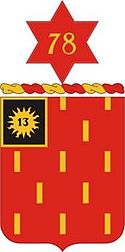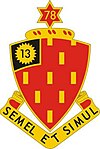78th Field Artillery Regiment (United States)
| 78th Field Artillery Regiment | |
|---|---|

Coat of arms
|
|
| Country |
|
| Branch | Army |
| Type | Field artillery |
| Motto(s) | SEMEL ET SIMUL (At Once and Together) |
| Insignia | |
| Distinctive unit insignia |  |
| U.S. Field Artillery Regiments | |
|---|---|
| Previous | Next |
| 77th Field Artillery | 79th Field Artillery |
The 78th Field Artillery Regiment is a field artillery regiment of the United States Army. Initially activated on 1 July 1916, the 78th Field Artillery Battalion did not see action in World War I, but would later be reactivated at the start of World War II and participate in the campaigns for Algeria-French Morocco, Sicily, Normandy, Northern France, Ardennes-Alsace, Central Europe, and the Rhineland with the 2d Armored Division. The 78th Artillery Battalion's six batteries were reorganized into separate battalions in 1957, with the 1st Battalion, 78th Field Artillery being the only remaining active unit of the 78th Field Artillery. The 1st Battalion, 78th Field Artillery is assigned to the 428th Field Artillery Brigade, supporting the Fires Center of Excellence mission through the conduct of Initial Entry Training in order to provide the Army with combat ready Field Artillery Soldiers. The 1st Battalion, 78th Field Artillery conducts Advanced Individual Training for the 13-series (Field Artillery) Military Occupational Specialties (MOS) of 13B (Cannon Crewmember), 13F (Joint Fire Support Specialist), 13J (Field Artillery Automated Tactical Data System Specialist), 13M (Multiple Launch Rocket System Crewmember), and 13R (Firefinder Radar Operator).
On 8 November 1942, the 78th Armored Field Artillery Battalion, part of the 2d Armored Division, approached the coast of French Morocco. At dusk the 78th landed at Safi and began to move inland. The batteries of the 78th were all equipped with T-19's and 105mm howitzers mounted on half-tracks. On 9 November, the 78th received word that a sizeable French force was marching from Marrakech to Safi. The landing team was ordered to intercept this force. That afternoon Battery C, 78th FA occupied a position to support a tank attack against the French and began to "rain steel" upon the enemy. The French, determined not to be pushed over, soon began firing on the 78th's position using World War 1 equipment. The antiquated French equipment did not present a legitimate threat, prompting General Harmon to disengage and march to his main objective -Casablanca. At dawn on 11 November, the armored column moved to the outskirts of Mazagan. Battery C, 78th FA and Battery B, 14th FA prepared to support an attack on the town soon after dawn. However, just before the attack, the French agreed to an armistice ending the "Battle of Mazagan". At Fedahla, due to heavy surf and equipment losses, the landing team which included Battery A, 78th FA, commanded by Captain George Bain, did not land until late in the evening on 9 November. On 10 November, the landing team started an envelopment that was soon called off upon receiving word of the armistice. At Port Lyautey only seven American tanks were on land when the French launched an attack with thirty-two Renault tanks in an effort to overrun the American beachhead. Captain C.W. Walter, commander Battery B, 78th FA, and Lieutenant Richard Moses, the forward observer, had landed with the seven American tanks. The two officers suddenly found themselves involved in serious action. The remainder of the landing team landed the next day. The team moved into position and kept the French at bay until the armistice.
...
Wikipedia
